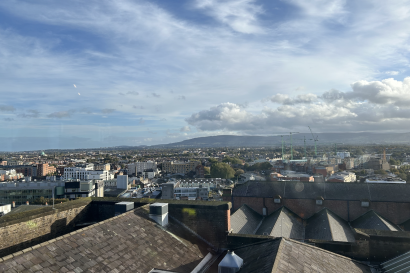





This Wednesday marks week 2 of my semestre en Santiago. Aside from attending orientation at the IES Abroad Center, the program provider through which I am studying abroad, since classes have not begun yet, I have had a lot of time to get to know Santiago outside of the classroom and familiarize myself with Chilean culture. Below is a list of the top 10 things I have learned during my time here:
1. While the list of chilenismos is endless, po, which I am convinced doesn’t actually mean anything, is often attached to the end of an affirmation or negation of something. Ex.) Person 1: Hace mucho frio afuera. Person 2: Si, po. Person 1: ¿Te gustaría un cafecito? Person 2: No, po. Estoy bien.
2. Chileans walk everywhere.
3. When Chileans are not walking everywhere, they are almost always using either the metro or the micro to get from Point A to Point B.
4. If you want to purchase something or be attended to, you cannot simply stand in line. You have to take a number. I learned that the hard way.
5. Being a Latin American country doesn’t make living in Chile cheaper. In fact, almost everything I have purchased here is more expensive. It doesn’t help that they don’t really use coupons here.
6. Santiago is one of the most polluted cities in the world. You can almost always expect to find dirt, dust, and other black particles in your snot.
7. Tortas, tortillas, empanadas, and nachos do NOT mean the same thing in Chile. Aguacate is palta, and pinche actually means pinch. (You see mom. I wasn’t actually cursing that one time I used pinche when Felix pinched me.)
8. On the topic of food, Chileans eat lunch and dinner way later than Americans, and some families even have a designated snack time around 8 called once.
9. Apparently using the word ahorita instead of ahora, despite the fact that Chileans love to add diminutives to everything, immediately lets them know you are Mexican.
10. And of course, my favorite: It doesn’t matter if you’re Hispanic in Chile, if you are not Chilean, you will still be referred to as a gringa. En Chile, soy gringa.
Because it is currently winter and Chile’s electrical outlets function on 220V, one of the first things I had to do when I got here was purchase a power converter in order to use some of the appliances I brought here—my straightener, my curling iron, my laptop, and of course my bed warmer. The only store where this is sold, however is Casa Royal which is in the Costanera Centro (check it out here: http://www.costaneracenter.cl/mall/tienda), only the biggest mall I have ever seen in my life. It has got 6 stories, and I will definitely be returning soon to purchase some new boots since the soles of mine seem to have disintegrated from all the walking I have been doing.
Aside from checking out the mall, during my time here I have already visited Valpariso, Viña del Mar, and el centro de Santiago, hiked the Andes, climbed to the top of Cerro Santa Lucia, attended an asado, found a Mexican restaurant I can go to when I miss enchiladas, fajitas, and tacos, visited a church in Ñuñoa, oh and I’ve got a flip phone. I can’t really text on it, never really had to learn how to, but now I can call people in Chile.
I miss my mom’s cooking, hanging out with my family, instant hot water, and other little luxuries, but I am super excited for the classes I am signed up for this semester, and I can’t wait to see what the coming months have in store.

Monica Melendez
<div> </div>
<div><span style="color: rgb(29, 29, 29); font-family: Arial, Verdana, sans-serif; font-size: 12px; line-height: normal; background-color: rgb(237, 237, 237);">Monica is a junior at Rice University studying History, Latin American Studies, and Spanish and Portuguese. Although both her parents were born in Central America, Latin America is still very much undiscovered territory for her. Monica's current research interests include the re-democratization of the Southern Cone following the fall of authoritarian regimes in the mid-to-late 80s. Additionally, she is interested in the progression of human rights in Latin America and the political and social role income inequality has played within the development of Latin American societies. Upon graduating Rice, Monica is looking to pursue her Ph. D. in Latin American History. Aside from being a great opportunity for self-discovery, she looks forward to integrating herself into Chilean society and gathering research for her senior thesis.</span></div>







